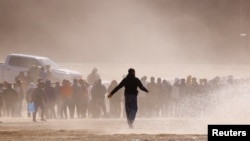The Biden administration is devising a strategy for the possible arrival of tens of thousands more migrants at the U.S.-Mexico border after the anticipated end of COVID-19 restrictions next month, scrambling to find potential holding centers, speed up deportations and increase processing of refugees abroad.
The administration is expected to announce a package of new measures as soon as this week that would include stepping up the currently small number of Latin Americans admitted through the U.S. refugee settlement program, three people familiar with the matter told Reuters.
At the same time, U.S. officials are expanding holding capacity for migrants at the border while piloting faster asylum screenings. One yet-unreported option under discussion is to process migrants at Fort Bliss, a military base near El Paso, Texas, two U.S. officials and a third person familiar with the matter told Reuters.
White House spokesperson Abdullah Hasan denied the base was being considered and the Pentagon said it had not received a request to use it for migrant processing.
Other steps are likely to include agreements or understandings with regional governments aimed at curbing migration heading north and increasing aid to migrants who have already arrived in those countries, according to the person familiar with the matter. Details were not immediately known.
The U.S. Department of Homeland Security (DHS) and U.S. State Department did not immediately respond to requests for comment.
The Biden plans aim to address a likely increase in unauthorized immigration after COVID border restrictions that have been in place since 2020 are set to end on May 11, barring any last-minute legal or congressional intervention.
The broader COVID public health emergency is scheduled to terminate on that date, undercutting the rationale for the restrictions, known as Title 42.
Biden, a Democrat who announced his 2024 reelection campaign this week, has struggled with record numbers of migrants caught crossing the U.S.-Mexico border and gradually toughened his approach to enforcement. Republicans have blamed Biden for abandoning hardline policies championed by Republican former President Donald Trump, currently the leading candidate for the party's presidential nomination.
The expansion of refugee processing in Latin America would come as the Biden administration has yet to restore refugee admissions after they were slashed under Trump.
Biden carved out 15,000 refugee slots for people in Latin America and the Caribbean in fiscal year 2022, which ended on Sept. 30, 2022, but only admitted about 2,500.
The administration accelerated the pace through the first six months of the current fiscal year, letting in 2,300 from the region but remains far away from the 15,000-person ceiling.
The Biden administration's latest border plan focuses on a soon-to-be-finalized regulation that would block most migrants crossing the border illegally from claiming asylum if they passed through another country without seeking refuge or failed to use lawful pathways to the United States. For the rule to function as an effective deterrent, U.S. authorities would detain people who cross the border and quickly process them for deportation.
Troy Miller, the acting commissioner of U.S. Customs and Border Protection (CBP), told lawmakers last week that he is preparing for the possibility that up to 10,000 migrants per day could attempt to enter the United States illegally — nearly double the daily average in March. Miller noted that an estimated 660,000 migrants are currently in Mexico, citing United Nations figures.
CBP has capacity to detain 6,000 migrants at the U.S.-Mexico border and plans to add space for 2,500 more, Miller said, adding that the agency has stepped up its ability to quickly transport migrants away from the border.
When crossings reached record highs in 2022, U.S. officials released thousands of migrants into Texas and Arizona border cities, triggering criticism from Republican governors who bused migrants to Democratic cities further north.
Fort Bliss, the Texas military base, is currently providing shelter to about 80 unaccompanied migrant children after housing thousands during a steep rise in crossings in 2021, which led to reports of overcrowding, unsanitary conditions, spoiled food and struggles with depression.













